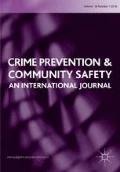Abstract
There has been a steep decline in child arrests in recent years. The Howard League Research Briefing Child Arrests in England and Wales 2017 attributes this to a Howard League programme of work with police. We show the decline in arrests began well before that programme of work, and conclude the Research Briefing’s claims are unfounded. However, there is strong evidence that the decline in arrests is due to the long-term fall in child offending rates, probably caused by security improvements. While we are sympathetic to the aims of the Howard League, if security is having such positive effects in terms of safer communities and fewer children being processed through the criminal justice system, then it should command wide support.

Source: Ministry of Justice (2018)
Similar content being viewed by others
References
Andersen, L.H., A.S.T. Anker, and H.S. Andersen. 2016. A formal decomposition of declining youth crime in Denmark. Demographic Research 35(44): 1303–1316.
BBC. 2018a. Child arrests in England fall by two thirds since 2010. BBC online. https://www.bbc.co.uk/news/uk-england-45471109. Accessed 5 Oct 2018.
BBC, 2018b. Child arrests in Wales fall by two thirds since 2010. BBC online. https://www.bbc.co.uk/news/uk-wales-45446752. Accessed 5 Oct 2018.
Brown, R. 2015. Reviewing the effectiveness of electronic vehicle immobilisation: Evidence from four countries. Security Journal 28(4): 329–351.
Crook, F. 2018. ‘Giving children a brighter future’ Statement in Howard League email distributing Child Arrests in England and Wales 2017. https://mailchi.mp/3c72ce6f994f/what-should-happen-next-454101?e=084a5eef51. Accessed 2 Oct 2018.
Farrell, G., G. Laycock, and N. Tilley. 2015. Debuts and legacies: The crime drop and the role of adolescence-limited and persistent offending. Crime Science 4(16): 1–10.
Farrell, G., N. Tilley, and A. Tseloni. 2014. Why the crime drop? Crime and Justice 43: 421–490.
Farrell, G., A. Tseloni, J. Mailley, and N. Tilley. 2011a. The crime drop and the security hypothesis. Journal of Research in Crime and Delinquency 48(2): 147–175.
Farrell, G., A. Tseloni, and N. Tilley. 2011b. The effectiveness of vehicle security devices and their role in the crime drop. Criminology and Criminal Justice 11(1): 21–35.
Farrell, G., A. Tseloni, and N. Tilley. 2016. Signature dish: Triangulation from data signatures to examine the role of security in falling crime. Methodological Innovations 9: 1–11.
Home Office 2017. Crime in England and Wales, year ending June 2017—Bulletin Tables. https://www.ons.gov.uk/releases/crimeinenglandandwalesyearendingjune2017. Accessed 4 Feb 2019.
Howard League. 2013. Child arrests in England and Wales 2008–2011. London: Howard League for Penal Reform.
Howard League. 2018a. ‘What we do’ Howard League website. https://howardleague.org/what-we-do/. Accessed 2 Oct 2018.
Howard League. 2018b. Child arrests in England and Wales 2017. London: Howard League for Penal Reform.
Matthews, B. 2014. Where have all the young offenders gone? Applied Quantitative Methods Network, University of Edinburgh.
Matthews, B., and J. Minton. 2017. Rethinking one of criminology’s ‘brute facts’: The age-crime curve and the crime drop in Scotland. European Journal of Criminology 15(3): 296–320.
Ministry of Justice. 2018. Youth Justice Statistics 2017/18. Statistics Bulletin (25 January 2018). London: Ministry of Justice.
National Center for Juvenile Justice. 2014. Juvenile arrest rates by offense, sex, and race. Washington DC: OJJDP, US Department of Justice.
Owen, N., and C. Cooper. 2013. The start of a criminal career: Does the type of debut offence predict future offending?. London: Home Office.
Payne, J., R. Brown and R. Broadhurst. 2018. Where have all the young offenders gone? Examining changes in offending between two NSW birth cohorts. Trends and Issues in Crime and Criminal Justice No 553. Canberra: Australian Institute of Criminology.
Smith, M.J., R.V. Clarke, and K. Pease. 2002. Anticipatory benefits in crime prevention. In Crime prevention studies: Vol. 13. Analysis for crime prevention, ed. N. Tilley, 71–88. Monsey, NY: Criminal Justice Press.
Sutherland, A., E. Disley, J. Cattell, and S. Bauchowitz. 2017. An analysis of trends in first time entrants to the youth justice system. Ministry of Justice Analytical Series. London: Ministry of Justice.
Svensson, R. 2002. Strategic offences in the criminal career context. British Journal of Criminology 42(2): 395–411.
Tilley, N., G. Farrell, and R.V. Clarke. 2015. Target suitability and the crime drop. In Routine activities and the criminal act, eds. M. Andresen and G. Farrell, 59–76. London: Palgrave Macmillan.
Tilley, N., G. Farrell, and A. Tseloni. 2019. Doing quantitative analysis in criminology. In Doing criminological research, eds. P. Davies and P. Francis. London: Sage.
Tseloni, A., J. Mailley, G. Farrell, and N. Tilley. 2010. Exploring the international decline in crime rates. European Journal of Criminology 7(5): 375–394.
Tseloni, A., G. Farrell, R. Thompson, E. Evans, L.E. Grove, and N. Tilley. 2017. Domestic burglary drop and the security hypothesis. Crime Science 6(3): 1–16.
Van Ours, J., and B. Vollaard. 2016. The engine immoboliser: A non-starter for car thieves. The Economic Journal 126(593): 1264–1291.
Author information
Authors and Affiliations
Corresponding author
Additional information
Publisher's Note
Springer Nature remains neutral with regard to jurisdictional claims in published maps and institutional affiliations.
Rights and permissions
About this article
Cite this article
Farrell, G., Laycock, G. & Tilley, N. What caused the decline in child arrests in England and Wales: The Howard League’s programme or something else?. Crime Prev Community Saf 21, 153–158 (2019). https://doi.org/10.1057/s41300-019-00067-5
Published:
Issue Date:
DOI: https://doi.org/10.1057/s41300-019-00067-5




